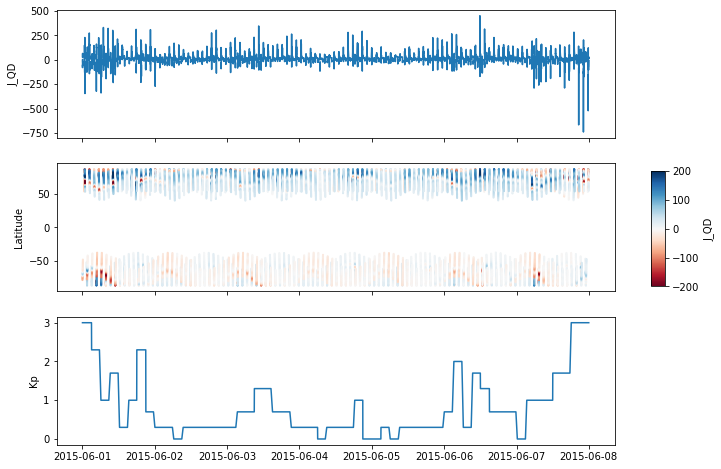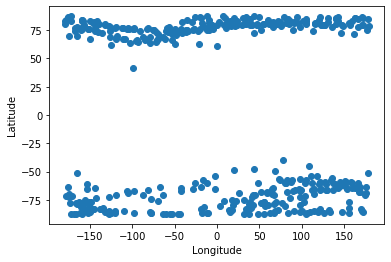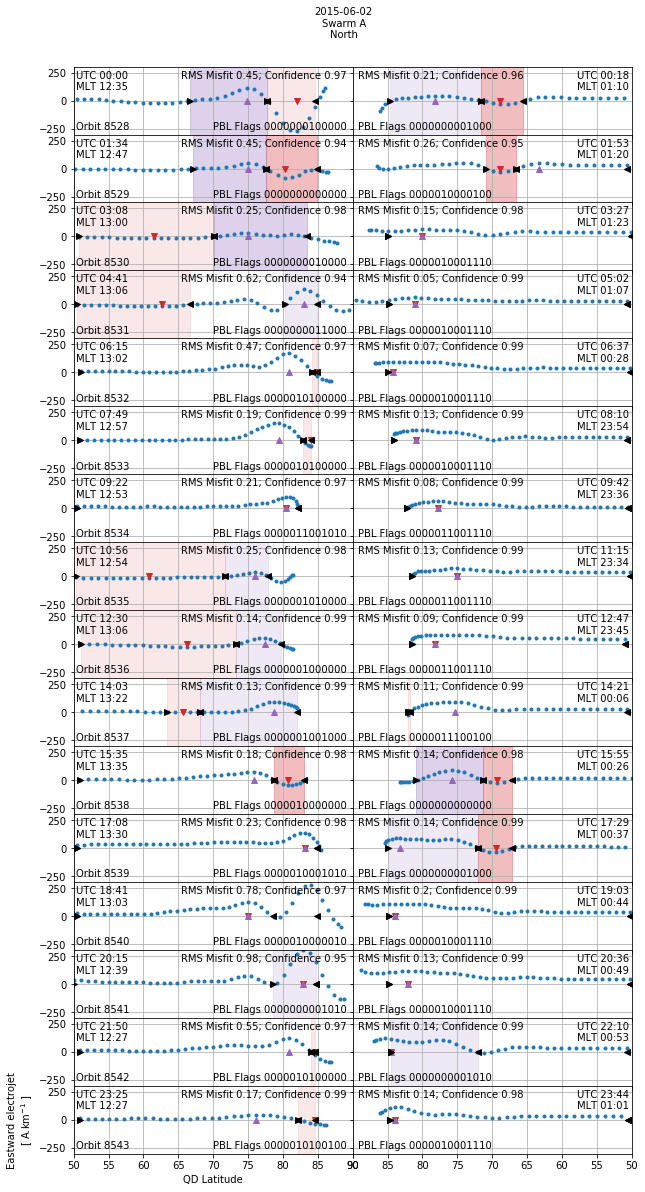Demo AEBS products (LC)¶
Authors: Ashley Smith
Abstract: Access to the AEBS products (“Auroral Electrojet and auroral Boundaries estimated from Swarm observations”). These are a family of L2 (fast-track) products:
AEJxLPL,AEJxLPS,AEJxPBL,AEJxPBS,AOBxFAC. The products provide latitude profiles of auroral electrojet currents from two methods - the “line current” (LC) and “Spherical Elementary Current Systems” (SECS) - as well as the locations of current maxima and minima and the boundaries of the current systems determined by each method, and the auroral oval boundaries determined from FAC observations.
AEBS product information¶
These comprise five products:
AEJxLPL: Auroral electrojets (AEJ) - Latitude profiles (LP) - Line current method (L)
AEJxLPS: Auroral electrojets (AEJ) - Latitude profiles (LP) - SECS method (S)
AEJxPBL: Auroral electrojets (AEJ) - Peaks and boundaries (PB) - Line current method (L)
AEJxPBS: Auroral electrojets (AEJ) - Peaks and boundaries (PB) - SECS method (S)
AOBxFAC: Auroral oval boundaries (AOB) - from FAC method
These products are updated on a daily basis through the fast-track Swarm processing chain and are defined along the orbits of each Swarm spacecraft.
The LC method produces only horizontal sheet current density (2D) while the SECS method produces both the horizontal sheet current density and the radial current density (3D) as well as a prediction for the satellite ground track location experiencing the greatest magnetic disturbance.
For the LPL (line current) products:
Horizontal current densities are given both in the NEC (geographic) frame (J_NE - North/East components) and the QD (quasi-dipole) frame (J_QD).
For the LPS (SECS) products:
The horizontal current densities are decomposed into curl-free (CF) and divergence-free (DF) parts and expressed in both the NEC and semi-QD frames: J_CF_NE, J_DF_NE, J_CF_SemiQD, J_DF_SemiQD. The radial current density is also given in the semi-QD frame: J_R.
The PBL and PBS products contain the current system peaks and boundaries determined from each of LPL and LPS respectively. The PBS product also contains a prediction for the location and size of the peak ground magnetic disturbance.
Documentation:
Not yet public but should appear at https://earth.esa.int/web/guest/missions/esa-eo-missions/swarm/data-handbook/level-2-product-definitions
ref SW‐DS‐DTU‐GS‐003_AEBS_PDD
Details on implementation in VirES and more demos:
https://github.com/pacesm/jupyter_notebooks/tree/master/AEBS
The layout of these data is quite complex and the original data are mapped to variables within VirES as detailed in:
https://github.com/pacesm/jupyter_notebooks/blob/master/AEBS/AEBS_00_data_access.ipynb
You can also see an overview of the collection and parameter naming in VirES at https://viresclient.readthedocs.io/en/latest/available_parameters.html#collections
Example with the AEJALPL: J_QD time series¶
Fetch the three collections: LPL, LPL:Quality, and PBL¶
start_time = dt.datetime(2015, 6, 1)
end_time = dt.datetime(2015, 6, 8)
spacecraft = 'A'
auxiliaries = ['OrbitNumber', 'QDLat', 'QDOrbitDirection', 'MLT', 'Kp']
# Fetch LPL
request.set_collection(f'SW_OPER_AEJ{spacecraft}LPL_2F')
request.set_products(
measurements=['J_NE', 'J_QD'],
auxiliaries=auxiliaries
)
data = request.get_between(start_time, end_time)
ds_lpl = data.as_xarray()
# Fetch LPL Quality
request.set_collection(f'SW_OPER_AEJ{spacecraft}LPL_2F:Quality')
request.set_products(
measurements=['RMS_misfit', 'Confidence'],
)
data = request.get_between(start_time, end_time)
ds_lplq = data.as_xarray()
# Fetch PBL
request.set_collection(f'SW_OPER_AEJ{spacecraft}PBL_2F')
request.set_products(
measurements=['PointType', 'Flags'],
auxiliaries=auxiliaries
)
data = request.get_between(start_time, end_time)
ds_pbl = data.as_xarray()
[1/1] Processing: 100%|██████████| [ Elapsed: 00:02, Remaining: 00:00 ]
Downloading: 100%|██████████| [ Elapsed: 00:00, Remaining: 00:00 ] (1.358MB)
[1/1] Processing: 100%|██████████| [ Elapsed: 00:01, Remaining: 00:00 ]
Downloading: 100%|██████████| [ Elapsed: 00:00, Remaining: 00:00 ] (0.038MB)
[1/1] Processing: 100%|██████████| [ Elapsed: 00:01, Remaining: 00:00 ]
Downloading: 100%|██████████| [ Elapsed: 00:00, Remaining: 00:00 ] (0.175MB)
ds_lpl:
<xarray.Dataset>
Dimensions: (NE: 2, Timestamp: 17087)
Coordinates:
* Timestamp (Timestamp) datetime64[ns] 2015-06-01T00:00:15.688632727 ... 2015-06-07T23:57:52.053164005
* NE (NE) <U1 'N' 'E'
Data variables:
Spacecraft (Timestamp) object 'A' 'A' 'A' 'A' 'A' ... 'A' 'A' 'A' 'A'
Latitude (Timestamp) float64 -79.2 -78.22 -77.24 ... 57.1 56.1 55.1
MLT (Timestamp) float64 17.6 17.32 17.05 ... 0.6985 0.685
Kp (Timestamp) float64 3.0 3.0 3.0 3.0 ... 3.0 3.0 3.0 3.0
Longitude (Timestamp) float64 178.7 179.9 -179.2 ... 0.05097 0.1309
OrbitNumber (Timestamp) int32 8512 8512 8512 8512 ... 8620 8620 8620
QDLat (Timestamp) float64 -77.66 -77.26 -76.8 ... 53.24 52.09
QDOrbitDirection (Timestamp) int8 1 1 1 1 1 1 1 1 ... -1 -1 -1 -1 -1 -1 -1
J_QD (Timestamp) float64 -58.71 -64.28 -72.47 ... 18.22 17.74
J_NE (Timestamp, NE) float64 58.18 -7.87 62.57 ... 1.769 17.65
Attributes:
Sources: ['SW_OPER_AEJALPL_2F_20150531T000000_20150531T235959_010...
MagneticModels: []
RangeFilters: []
ds_lplq:
<xarray.Dataset>
Dimensions: (Timestamp: 431)
Coordinates:
* Timestamp (Timestamp) datetime64[ns] 2015-06-01T00:05:37 ... 2015-06-07T23:55:23.500000
Data variables:
Spacecraft (Timestamp) object 'A' 'A' 'A' 'A' 'A' ... 'A' 'A' 'A' 'A' 'A'
Confidence (Timestamp) float64 0.9642 0.9695 0.9793 ... 0.9392 0.9605
RMS_misfit (Timestamp) float64 0.3433 0.5879 0.5471 ... 0.1878 1.775 0.5764
Attributes:
Sources: ['SW_OPER_AEJALPL_2F_20150531T000000_20150531T235959_010...
MagneticModels: []
RangeFilters: []
ds_pbl:
<xarray.Dataset>
Dimensions: (Timestamp: 2586)
Coordinates:
* Timestamp (Timestamp) datetime64[ns] 2015-06-01T00:02:07.298531294 ... 2015-06-07T23:58:07.682382822
Data variables:
Spacecraft (Timestamp) object 'A' 'A' 'A' 'A' 'A' ... 'A' 'A' 'A' 'A'
Flags (Timestamp) uint8 80 80 80 80 80 ... 132 132 132 132 132
Latitude (Timestamp) float64 -72.2 -69.33 -66.45 ... 61.09 54.1
PointType (Timestamp) uint16 7 1 11 6 0 10 2 0 ... 14 6 0 10 7 1 11
MLT (Timestamp) float64 15.95 15.51 15.15 ... 0.7821 0.6724
Kp (Timestamp) float64 3.0 3.0 3.0 3.0 ... 3.0 3.0 3.0 3.0
Longitude (Timestamp) float64 -176.0 -174.9 ... -0.4809 0.2037
OrbitNumber (Timestamp) int32 8512 8512 8512 8512 ... 8620 8620 8620
QDLat (Timestamp) float64 -73.62 -71.39 -68.96 ... 58.9 50.93
QDOrbitDirection (Timestamp) int8 1 1 1 1 1 1 1 1 ... 1 1 -1 -1 -1 -1 -1 -1
Attributes:
Sources: ['SW_OPER_AEJAPBL_2F_20150101T000000_20151231T235959_010...
MagneticModels: []
RangeFilters: []
Reconstruct ds_pbl into a more manageable form¶
Split PointType apart into separate boolean arrays, one for each point type
For more info on PointType, see:
https://nbviewer.jupyter.org/github/pacesm/jupyter_notebooks/blob/master/AEBS/AEBS_00_data_access.ipynb#AEJxPBL-product
# Meaning of PointType
PointType_meanings = {
"WEJ_peak": 0, # minimum
"EEJ_peak": 1, # maximum
"WEJ_eq_bound_s": 2, # equatorward (pair start)
"EEJ_eq_bound_s": 3,
"WEJ_po_bound_s": 6, # poleward
"EEJ_po_bound_s": 7,
"WEJ_eq_bound_e": 10, # equatorward (pair end)
"EEJ_eq_bound_e": 11,
"WEJ_po_bound_e": 14, # poleward
"EEJ_po_bound_e": 15,
}
# Add new data variables (boolean Type) according to the dictionary above
ds_pbl = ds_pbl.assign(
{name: ds_pbl["PointType"] == PointType_meanings[name]
for name in PointType_meanings.keys()}
)
ds_pbl
<xarray.Dataset>
Dimensions: (Timestamp: 2586)
Coordinates:
* Timestamp (Timestamp) datetime64[ns] 2015-06-01T00:02:07.298531294 ... 2015-06-07T23:58:07.682382822
Data variables:
Spacecraft (Timestamp) object 'A' 'A' 'A' 'A' 'A' ... 'A' 'A' 'A' 'A'
Flags (Timestamp) uint8 80 80 80 80 80 ... 132 132 132 132 132
Latitude (Timestamp) float64 -72.2 -69.33 -66.45 ... 61.09 54.1
PointType (Timestamp) uint16 7 1 11 6 0 10 2 0 ... 14 6 0 10 7 1 11
MLT (Timestamp) float64 15.95 15.51 15.15 ... 0.7821 0.6724
Kp (Timestamp) float64 3.0 3.0 3.0 3.0 ... 3.0 3.0 3.0 3.0
Longitude (Timestamp) float64 -176.0 -174.9 ... -0.4809 0.2037
OrbitNumber (Timestamp) int32 8512 8512 8512 8512 ... 8620 8620 8620
QDLat (Timestamp) float64 -73.62 -71.39 -68.96 ... 58.9 50.93
QDOrbitDirection (Timestamp) int8 1 1 1 1 1 1 1 1 ... 1 1 -1 -1 -1 -1 -1 -1
WEJ_peak (Timestamp) bool False False False ... False False False
EEJ_peak (Timestamp) bool False True False ... False True False
WEJ_eq_bound_s (Timestamp) bool False False False ... False False False
EEJ_eq_bound_s (Timestamp) bool False False False ... False False False
WEJ_po_bound_s (Timestamp) bool False False False ... False False False
EEJ_po_bound_s (Timestamp) bool True False False ... True False False
WEJ_eq_bound_e (Timestamp) bool False False False ... False False False
EEJ_eq_bound_e (Timestamp) bool False False True ... False False True
WEJ_po_bound_e (Timestamp) bool False False False ... False False False
EEJ_po_bound_e (Timestamp) bool False False False ... False False False
Attributes:
Sources: ['SW_OPER_AEJAPBL_2F_20150101T000000_20151231T235959_010...
MagneticModels: []
RangeFilters: []Merge (ds_lpl, ds_pbl) into one ds¶
ds_pbl contains duplicate Timestamp entries because some points in the time series contain more than one identified PointType. This is a problem for straightforward merging with ds_lpl. This can be worked around with this strategy:
Create a new dataset from the newly created PointType arrays, without the repeating timestamps
Merge this with the LPL dataset - this is an outer merge since the PBL contains timestamps that don’t appear in the LPL data
def drop_duplicate_times(_ds):
_, index = np.unique(_ds['Timestamp'], return_index=True)
return _ds.isel(Timestamp=index)
def merge_attrs(_ds1, _ds2):
attrs = {"Sources":[], "MagneticModels":[], "RangeFilters":[]}
for item in ["Sources", "MagneticModels", "RangeFilters"]:
attrs[item] = list(set(_ds1.attrs[item] + _ds2.attrs[item]))
return attrs
# Create new dataset from just the newly created PointType arrays
# This is created on a non-repeating Timestamp coordinate
ds = xr.Dataset(
{name: ds_pbl[name].where(ds_pbl[name], drop=True)
for name in PointType_meanings.keys()}
)
# Merge in the positional and auxiliary data
data_vars = list(set(ds_pbl.data_vars).difference(set(PointType_meanings.keys())))
data_vars.remove("PointType")
ds = ds.merge(
(ds_pbl[data_vars]
.pipe(drop_duplicate_times))
)
# Merge together with the LPL data
# Note that the Timestamp coordinates aren't equal
# Separately merge data with matching and missing time sample points in ds_lpl
idx_present = list(set(ds["Timestamp"].values).intersection(set(ds_lpl["Timestamp"].values)))
idx_missing = list(set(ds["Timestamp"].values).difference(set(ds_lpl["Timestamp"].values)))
# Override prioritises the first dataset (ds_lpl) where there are conflicts
ds2 = ds_lpl.merge(ds.sel(Timestamp=idx_present), join="outer", compat="override")
ds2 = ds2.merge(ds.sel(Timestamp=idx_missing), join="outer")
# Update the metadata
ds2.attrs = merge_attrs(ds_lpl, ds_pbl)
# Switch the point type arrays to uint8 or bool for performance?
# But the .where operations later cast them back to float64 since gaps are filled with nan
for name in PointType_meanings.keys():
ds2[name] = ds2[name].astype("uint8").fillna(False)
# ds2[name] = ds2[name].fillna(False).astype(bool)
ds = ds2
ds
<xarray.Dataset>
Dimensions: (NE: 2, Timestamp: 17520)
Coordinates:
* Timestamp (Timestamp) datetime64[ns] 2015-06-01T00:00:15.688632727 ... 2015-06-07T23:58:07.682382822
* NE (NE) <U1 'N' 'E'
Data variables:
Spacecraft (Timestamp) object 'A' 'A' 'A' 'A' 'A' ... 'A' 'A' 'A' 'A'
Latitude (Timestamp) float64 -79.2 -78.22 -77.24 ... 56.1 55.1 54.1
MLT (Timestamp) float64 17.6 17.32 17.05 ... 0.685 0.6724
Kp (Timestamp) float64 3.0 3.0 3.0 3.0 ... 3.0 3.0 3.0 3.0
Longitude (Timestamp) float64 178.7 179.9 -179.2 ... 0.1309 0.2037
OrbitNumber (Timestamp) float64 8.512e+03 8.512e+03 ... 8.62e+03
QDLat (Timestamp) float64 -77.66 -77.26 -76.8 ... 52.09 50.93
QDOrbitDirection (Timestamp) float64 1.0 1.0 1.0 1.0 ... -1.0 -1.0 -1.0
J_QD (Timestamp) float64 -58.71 -64.28 -72.47 ... 17.74 nan
J_NE (Timestamp, NE) float64 58.18 -7.87 62.57 ... nan nan
WEJ_peak (Timestamp) uint8 0 0 0 0 0 0 0 0 0 ... 0 0 0 0 0 0 0 0 0
EEJ_peak (Timestamp) uint8 0 0 0 0 0 0 0 0 0 ... 0 1 0 0 0 0 0 0 0
WEJ_eq_bound_s (Timestamp) uint8 0 0 0 0 0 0 0 0 0 ... 0 0 0 0 0 0 0 0 0
EEJ_eq_bound_s (Timestamp) uint8 0 0 0 0 0 0 0 0 0 ... 0 0 0 0 0 0 0 0 0
WEJ_po_bound_s (Timestamp) uint8 0 0 0 0 0 0 0 0 0 ... 0 0 0 0 0 0 0 0 0
EEJ_po_bound_s (Timestamp) uint8 0 0 0 0 0 0 0 0 1 ... 0 0 0 0 0 0 0 0 0
WEJ_eq_bound_e (Timestamp) uint8 0 0 0 0 0 0 0 0 0 ... 0 0 0 0 0 0 0 0 0
EEJ_eq_bound_e (Timestamp) uint8 0 0 0 0 0 0 0 0 0 ... 0 0 0 0 0 0 0 0 1
WEJ_po_bound_e (Timestamp) uint8 0 0 0 0 0 0 0 0 0 ... 0 0 0 0 0 0 0 0 0
EEJ_po_bound_e (Timestamp) uint8 0 0 0 0 0 0 0 0 0 ... 0 0 0 0 0 0 0 0 0
Flags (Timestamp) float64 nan nan nan nan ... nan nan nan 132.0
Attributes:
Sources: ['SW_OPER_MAGA_LR_1B_20150604T000000_20150604T235959_050...
MagneticModels: []
RangeFilters: []We can extract locations within ds where a certain point type is identified, and plot them:
Append the PBL Flags information into the LPL:Quality dataset to use as a lookup table¶
<xarray.Dataset>
Dimensions: (Timestamp: 431)
Coordinates:
* Timestamp (Timestamp) datetime64[ns] 2015-06-01T00:05:37 ... 2015-06-07T23:55:23.500000
Data variables:
Spacecraft (Timestamp) object 'A' 'A' 'A' 'A' 'A' ... 'A' 'A' 'A' 'A' 'A'
Confidence (Timestamp) float64 0.9642 0.9695 0.9793 ... 0.9392 0.9605
RMS_misfit (Timestamp) float64 0.3433 0.5879 0.5471 ... 0.1878 1.775 0.5764
Flags_PBL (Timestamp) uint8 80 16 8 196 96 16 8 ... 206 0 0 64 196 0 132
Attributes:
Sources: ['SW_OPER_AEJALPL_2F_20150531T000000_20150531T235959_010...
MagneticModels: []
RangeFilters: []Overview of the week accessed¶
NB the coloured plot suffers from overplotting lines as we have not separated the ascending/descending sectors of the passes over the poles.
fig, axes = plt.subplots(nrows=3, ncols=1, sharex=True, figsize=(10, 8))
axes[0].plot(ds["Timestamp"], ds["J_QD"])
axes[0].set_ylabel("J_QD")
cmap = mpl.cm.RdBu
norm = plt.Normalize(-200, 200)
axes[1].scatter(
x=ds["Timestamp"].values, y=ds["Latitude"].values, c=ds["J_QD"].values,
s=1, cmap=cmap, norm=norm
)
ax_cbar = fig.add_axes([0.95, 0.4, 0.02, 0.2])
mpl.colorbar.ColorbarBase(
ax_cbar, cmap=cmap, norm=norm, orientation="vertical", label="J_QD"
)
axes[1].set_ylabel("Latitude")
_da_kp = ds["Kp"].dropna(dim="Timestamp")
axes[2].plot(_da_kp["Timestamp"], _da_kp)
axes[2].set_ylabel("Kp");
/opt/conda/lib/python3.7/site-packages/pandas/plotting/_matplotlib/converter.py:103: FutureWarning: Using an implicitly registered datetime converter for a matplotlib plotting method. The converter was registered by pandas on import. Future versions of pandas will require you to explicitly register matplotlib converters.
To register the converters:
>>> from pandas.plotting import register_matplotlib_converters
>>> register_matplotlib_converters()
warnings.warn(msg, FutureWarning)

Orbit-by-orbit plot of one day¶
# Bit numbers which indicate non-nominal state
# Check SW-DS-DTU-GS-003_AEBS_PDD for details
BITS_PBL_FLAGS_EEJ_MINOR = (2, 3, 6)
BITS_PBL_FLAGS_WEJ_MINOR = (4, 5, 6)
BITS_PBL_FLAGS_EEJ_BAD = (0, 7, 8, 11)
BITS_PBL_FLAGS_WEJ_BAD = (1, 9, 10, 12)
def check_PBL_Flags(flags=0b0, EJ_type="WEJ"):
"""Return "good", "poor", or "bad" depending on status"""
def _check_bits(bitno_set):
return any(flags & (1 << bitno) for bitno in bitno_set)
if EJ_type == "WEJ":
if _check_bits(BITS_PBL_FLAGS_WEJ_BAD):
return "bad"
elif _check_bits(BITS_PBL_FLAGS_WEJ_MINOR):
return "poor"
else:
return "good"
elif EJ_type == "EEJ":
if _check_bits(BITS_PBL_FLAGS_EEJ_BAD):
return "bad"
elif _check_bits(BITS_PBL_FLAGS_EEJ_MINOR):
return "poor"
else:
return "good"
glyphs = {
"WEJ_peak": {"marker": 'v', "color":'tab:red'}, # minimum
"EEJ_peak": {"marker": '^', "color":'tab:purple'}, # maximum
"WEJ_eq_bound_s": {"marker": '>', "color":'black'}, # equatorward (pair start)
"EEJ_eq_bound_s": {"marker": '>', "color":'black'},
"WEJ_po_bound_s": {"marker": '>', "color":'black'}, # poleward
"EEJ_po_bound_s": {"marker": '>', "color":'black'},
"WEJ_eq_bound_e": {"marker": '<', "color":'black'}, # equatorward (pair end)
"EEJ_eq_bound_e": {"marker": '<', "color":'black'},
"WEJ_po_bound_e": {"marker": '<', "color":'black'}, # poleward
"EEJ_po_bound_e": {"marker": '<', "color":'black'},
}
def plot_stack(ds, hemisphere="North"):
if hemisphere == "North":
ds = ds.where(ds["Latitude"]>0, drop=True)
elif hemisphere == "South":
ds = ds.where(ds["Latitude"]<0, drop=True)
# Generate plot with split by columns: ascending/descending to/from pole
# by rows: successive orbits
fig, axes = plt.subplots(
nrows=len(ds.groupby("OrbitNumber")), ncols=2, sharex="col", sharey="all",
figsize=(10, 20)
)
max_ylim = np.max(np.abs(ds["J_QD"]))
# Loop through each orbit
for i, (_, ds_orbit) in enumerate(ds.groupby("OrbitNumber")):
if hemisphere == "North":
ds_orb_asc = ds_orbit.where(ds_orbit["QDOrbitDirection"] == 1, drop=True)
ds_orb_desc = ds_orbit.where(ds_orbit["QDOrbitDirection"] == -1, drop=True)
if hemisphere == "South":
ds_orb_asc = ds_orbit.where(ds_orbit["QDOrbitDirection"] == -1, drop=True)
ds_orb_desc = ds_orbit.where(ds_orbit["QDOrbitDirection"] == 1, drop=True)
# Loop through ascending and descending sections
for j, _ds in enumerate((ds_orb_asc, ds_orb_desc)):
# Line plot of current strength
axes[i, j].plot(
_ds["QDLat"], _ds["J_QD"],
color="tab:blue", marker=".", linestyle=""
)
# Plot glyphs at the peaks and boundaries locations
for name in glyphs.keys():
__ds = _ds.where(_ds[name], drop=True)
try:
for qdlat in __ds["QDLat"]:
axes[i, j].plot(
qdlat, 0,
marker=glyphs[name]["marker"], color=glyphs[name]["color"]
)
except Exception:
pass
# Identify Quality and Flags info
# Use either the start time of the section or the end, depending on asc or desc
index = 0 if j == 0 else -1
t = _ds["Timestamp"].isel(Timestamp=index).values
_ds_qualflags = ds_lplq.sel(Timestamp=t, method="nearest")
pbl_flags = int(_ds_qualflags["Flags_PBL"].values)
lpl_rms_misfit = float(_ds_qualflags["RMS_misfit"].values)
lpl_confidence = float(_ds_qualflags["Confidence"].values)
# Shade WEJ and EEJ regions, only if well-defined
# def _shade_EJ_region(_ds=None, EJ="WEJ", color="tab:red", alpha=0.3):
wej_status = check_PBL_Flags(pbl_flags, "WEJ")
eej_status = check_PBL_Flags(pbl_flags, "EEJ")
if wej_status in ["good", "poor"]:
alpha = 0.3 if wej_status == "good" else 0.1
try:
WEJ_left = _ds.where(
(_ds["WEJ_eq_bound_s"] == 1) | (_ds["WEJ_po_bound_s"] == 1), drop=True)
WEJ_right = _ds.where(
(_ds["WEJ_eq_bound_e"] == 1) | (_ds["WEJ_po_bound_e"] == 1), drop=True)
x1 = WEJ_left["QDLat"][0]
x2 = WEJ_right["QDLat"][0]
axes[i, j].fill_betweenx(
[-max_ylim, max_ylim], [x1, x1], [x2, x2], color="tab:red", alpha=alpha)
except Exception:
pass
if eej_status in ["good", "poor"]:
alpha = 0.3 if eej_status == "good" else 0.15
try:
EEJ_left = _ds.where(
(_ds["EEJ_eq_bound_s"] == 1) | (_ds["EEJ_po_bound_s"] == 1), drop=True)
EEJ_right = _ds.where(
(_ds["EEJ_eq_bound_e"] == 1) | (_ds["EEJ_po_bound_e"] == 1), drop=True)
x1 = EEJ_left["QDLat"][0]
x2 = EEJ_right["QDLat"][0]
axes[i, j].fill_betweenx(
[-max_ylim, max_ylim], [x1, x1], [x2, x2], color="tab:purple", alpha=alpha)
except Exception:
pass
# Write the LPL:Quality and PBL Flags info
ha = "right" if j == 0 else "left"
textx = 0.98 if j == 0 else 0.02
axes[i, j].text(
textx, 0.95,
f"RMS Misfit {np.round(lpl_rms_misfit, 2)}; Confidence {np.round(lpl_confidence, 2)}",
transform=axes[i, j].transAxes, verticalalignment="top", horizontalalignment=ha
)
axes[i, j].text(
textx, 0.05,
f"PBL Flags {pbl_flags:013b}",
transform=axes[i, j].transAxes, verticalalignment="bottom", horizontalalignment=ha
)
# Write the start/end time and MLT of the section, and the orbit number
def _format_utc(t):
return f"UTC {t.strftime('%H:%M')}"
def _format_mlt(mlt):
hour, fraction = divmod(mlt, 1)
t = dt.time(int(hour), minute=int(60*fraction))
return f"MLT {t.strftime('%H:%M')}"
# Left part (section starting UTC, MLT, OrbitNumber)
time_s = pd.to_datetime(ds_orb_asc["Timestamp"].isel(Timestamp=0).data)
mlt_s = ds_orb_asc["MLT"].dropna(dim="Timestamp").isel(Timestamp=0).data
orbit_number = int(ds_orb_asc["OrbitNumber"].isel(Timestamp=0).data)
axes[i, 0].text(
0.01, 0.95, f"{_format_utc(time_s)}\n{_format_mlt(mlt_s)}",
transform=axes[i, 0].transAxes, verticalalignment="top"
)
axes[i, 0].text(
0.01, 0.05, f"Orbit {orbit_number}",
transform=axes[i, 0].transAxes, verticalalignment="bottom"
)
# Right part (section ending UTC, MLT)
time_e = pd.to_datetime(ds_orb_desc["Timestamp"].isel(Timestamp=-1).data)
mlt_e = ds_orb_desc["MLT"].dropna(dim="Timestamp").isel(Timestamp=-1).data
axes[i, 1].text(
0.99, 0.95, f"{_format_utc(time_e)}\n{_format_mlt(mlt_e)}",
transform=axes[i, 1].transAxes, verticalalignment="top", horizontalalignment="right"
)
# Extra config of axes and figure text
axes[0, 0].set_ylim(-max_ylim, max_ylim)
if hemisphere == "North":
axes[0, 0].set_xlim(50, 90)
axes[0, 1].set_xlim(90, 50)
elif hemisphere == "South":
axes[0, 0].set_xlim(-50, -90)
axes[0, 1].set_xlim(-90, -50)
for ax in axes.flatten():
ax.grid()
axes[-1, 0].set_xlabel("QD Latitude")
axes[-1, 0].set_ylabel("Eastward electrojet\n[ A.km$^{-1}$ ]")
time = pd.to_datetime(ds["Timestamp"].isel(Timestamp=0).data)
spacecraft = ds["Spacecraft"].dropna(dim="Timestamp").isel(Timestamp=0).data
fig.text(
0.5, 0.9, f"{time.strftime('%Y-%m-%d')}\nSwarm {spacecraft}\n{hemisphere}",
transform=fig.transFigure, horizontalalignment="center",
)
fig.subplots_adjust(wspace=0, hspace=0)
return fig, axes
def plot_day(ds, day="20150101", hemisphere="North"):
ds = ds.sel(Timestamp=day)
fig, axes = plot_stack(ds, hemisphere)
return fig, axes
plot_stack() can be used to build the plot from a given dataset, separately for each hemisphere. plot_day() selects and plots a particular day.
Consecutive orbits are shown in consecutive rows, centred over the magnetic pole (defined by quasi-dipole latitude). The starting and ending times (UTC and MLT) of the orbital section are shown at the left and right. Westward (WEJ) and Eastward (EEJ) electrojet extents and peak intensities are indicated:
Blue dots: Estimated current density, J
Red/Purple shaded region: WEJ/EEJ extent (boundaries marked by black triangles)
Red/Purple triangles: Locations of peak WEJ/EEJ intensity

